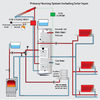My bother-in-law had a home with solar, wood, LPG, and electric all connected to both heat house and domestic hot water, seemed great system, but the down side was installation cost, so when he moved, he did not repeat it.
Central heating is a compromise, the cost of any money saving system has to get the money back in around 25 years, over 25 years and interest on the money means it does not work, and with any system where the components have a limited life, then the time is clearly reduced, so with central heating looking at around 10 to 15 years maximum.
So if spending £400 per annum on fuel, and the system can save 20% of fuel costs, and the interest rate is 5% then we are looking at a ceiling of around £1000 after which you will never regain what you spend, his system cost around £10,000 so you can quickly see it would never pay for its self.
OK some bits are not only about money, to have a warm house to return to is an advantage, and I like looking at a wood burning fire, however I don't like dusting, or carrying wood into the house or ash out of the house, I have electronic TRV heads in most rooms, and can easy turn off the heating when the room not used, but I don't, and I leave doors open, I have geofencing, but have hardly left the house in the last year, so that does not help.
So it is a compromise, not perfect, but good enough.
Solid fuel has always been a problem, the main problem is combustion air, we all know it should be drawn from outside, if you draw the air from inside, then it causes a draft, but my house has no ducts to outside, and it would need a lot of work to fit a wood burner that did draw air from outside.
The next problem is tar build up, particular emissions, and loss of energy through the flue, in the main this means until the wood or coal is turned to charcoal or coke, the fire has a fixed rate of burn, too cool and particular emissions and tar, too hot and inefficient, this also means you need doors, so idea of sitting in front of living flame is only an idea, you have to run with doors shut, and since you don't want a fixed rate of heat into the room, it needs a heat exchanger and a method to store excess heat for use latter.
To store the heat you need to have room in the store, so not less than 60°C or legionnaires problem, and at 100°C water boils, so only 60 - 90°C so the size is very large, and so also heavy, you can't rely on electric it needs thermo syphon, so storage needs to be on upper floors, so due to weight the floor needs to be very strong.
So in real terms the house is built around the heating, near impossible to install as an after thought. I had a friend who used wood burners and he needed to store the wood for three years before use, so

this was around 1/3 of his wood store, yes there are some really clever wood burners, this

looks really good, until you realise it uses an electric pump, so you need back up pumps, generators etc to run it safely. This

seems a great wood burner, try getting house insurance once installed. And this

seemed the bees knees condensating wood burner, but again problem arises if you lose power. This

looks great until you price it all up, and unless like my friend you have 20 acres of wood land getting the wood is not easy, around 2000 you could get old pallets and loads of other old wood, today there are just too many people trying to find cheap wood, the heritage railway I work at needs wood just to light the fires, and they struggle getting enough. And coal goes off, once coal is out of the ground it starts to degrade, so once the last Welsh steam coal mine closes then heritage railways will have a problem getting good coal. Yes with a larger fire box they could work, but that would mean a completely redesigned engine, the same applies to wood burners at home.
Nearly all wood produces the same calorific value per unit weight, but it is not the weight that matters, it is the volume, so a fire designed for hard wood is no good with soft wood, etc.






